#Field Inspection Software
Explore tagged Tumblr posts
Text
The construction industry is renowned for its complexity, with projects encompassing numerous phases, stakeholders, and regulatory requirements. Maintaining quality, ensuring safety, and adhering to project timelines are constant challenges. Field inspection software has emerged as a game-changer, empowering construction professionals with digital tools that streamline processes, enhance collaboration, and drive efficiency. This whitepaper explores the significance of field inspection software, specifically focusing on the comprehensive solutions offered by iFieldSmart Technologies.
#FieldInspectionSoftware #ConstructionTech #ConstructionInnovation #InspectionSolutions #DigitalConstruction #ConstructionSoftware #ProjectManagement #ConstructionIndustry #ConstructionSolutions #ConstructionAutomation #ConstructionMonitoring #InnovationInConstruction
#Field Inspection Software#civil engineering#construction software#construction management software#Construction Inspection Software#Construction Site Inspection Software#construction tech
0 notes
Text
Construction Inspection Software is a transformative tool that empowers construction teams to streamline the inspection process, improve communication, and enhance project outcomes. With its advanced features, mobile accessibility, and seamless collaboration capabilities, Construction Software is indispensable for modern construction projects. As the construction industry continues to evolve, Construction inspection Software will play an increasingly vital role in ensuring the success and sustainability of construction projects worldwide. Embrace the power of Construction Field Inspection Software and unlock the full potential of your construction quality assurance efforts.
Visit : www.ifieldsmart.com/inspections
#Construction Inspection Software#Construction Site Inspection Software#field inspection#field inspection software#inspection software#construction management software#construction software#construction project management#ifieldmsart#construction#civil#civil engineering#building technology#civil industry#architect
0 notes
Note
Stellium in planet & house midheaven persona chart
what's a midheaven? how does a stellium effect the midheaven persona?
paid reading options: astrology menu & cartomancy menu
enjoy my work? help me continue creating by tipping on ko-fi or paypal. your support keeps the magic alive!
first things first, the midheaven can tell you about your professional path, social standings, and overall public persona.
more specifically, you can tell who a person is professionally, what kind of public/visible achievements they have in life, the work they are drawn to, how they show up when they are given responsibility, goals they have, how they seek to achieve these goals, etc.
secondly, the midheaven persona can show you a bigger picture of what is in the natal chart regarding the general midheaven.
lastly, a stellium found in your midheaven persona has to be inspected carefully - is it mainly personal planets or generational planets? is it the sign, the house, or both?
example one: a sagittarius stellium spread across the 1h and 2h consisting of the sun, mercury, and pluto. this is a person ripe with knowledge. they are knowledge hungry - they starve for new experiences. they crave life changing experiences that broadens their perception of the world or even the universe. they appear funny and opinionated - with pluto's influence they could have a darker humor and harsh opinions that make them sound pessimistic. they seek a career that helps them grow and learn - when the learning stops, they are likely to seek a new job entirely. they might even change their field entirely. these people might have multiple degrees and certifications that are considered prestigious. these people are often professors, found in leadership roles, self-employed, famous, working alone, finance, journalists, etc.
example two: an aquarius stellium in the 3h consisting of venus, uranus, and neptune. these people follow no path in particular - it is unlikely that they will stay anywhere for the entirety of their life. they are likely to strike out on their own - become an entrepreneur at some point. they prioritize others over themselves where work is involved. often technology is very important to them and their career - this gives ai or online marketing vibes (the aesthetic is everything). these people are often software developers, accountants, crafters, marketers, human resources, writers, event planners, politicians, sales people, information processing, teaching, technological services, etc.
have ideas for new content? please use my “suggest a post topic” button!
return to nox's guide to metaphysics
return to the masterlist of planetary & object persona chart
© a-d-nox 2024 all rights reserved
#astrology#astro community#astro placements#astro chart#natal chart#astrology tumblr#persona chart#astrology chart#astrology readings#astro notes#astro observations#astroblr#astrology blog#midheaven#mc#persona chart observations#mc persona chart
87 notes
·
View notes
Text

An interactive evacuation zone map, touted by the Israeli military as an innovation in humanitarian process, was revealed to rely on a subset of an internal Israeli military intelligence database. The US-based software developer who revealed the careless error has determined -> that the database was in use since at least 2022 and was updated through December of 2023.
On Tuesday, July 9th, we discovered an interactive version of the evacuation map while examining a page on the IDF's Arabic-language website accessible via a QR code -> published on an evacuation order leaflet.
The map is divided into "population blocks" an IDF term to refer to the 620 polygons used to divide Gaza into sectors that a user can zoom into and out of.
However each request to the site pulls not only the polygon -> boundaries but the demographic information assigned to that sector, including which families - and how many. members - live there.
𝐃𝐢𝐬𝐜𝐨𝐯𝐞𝐫𝐲 𝐨𝐟 𝐈𝐧𝐭𝐞𝐫𝐚𝐜𝐭𝐢𝐯𝐞 𝐄𝐯𝐚𝐜𝐮𝐚𝐭𝐢𝐨𝐧 𝐌𝐚𝐩𝐬:
Evacuation maps have played a central role -> in determining which sectors of Gaza were deemed "safe", but repeated instances of Israeli bombing in "safe" sectors has prompted international bodies to state "nowhere in Gaza is safe"
To determine how these sectors have been affected over time, assess the presence of vital -> civilian infrastructure, and gauge the potential impact on the population following the military's evacuation calls to Gaza City residents, the latest of which was two days ago, our team created a map tied to a database using software known as a "geographic information system” -> With the help of volunteer GIS developers, our map of Gaza included individual layers for hospitals, educational facilities, roads, and municipal boundaries.
This endeavor took an unexpected turn earlier this week when we started to work on -> the layer of "evacuation population blocks"
using a map shared to the Israeli military's Arabic site. Unlike static images, these maps responded interactively to zooming and panning. A software developer suggested that dynamic interaction was possible because the coordinates -> of various "population blocks" were delivered to the browser with each request, potentially retrieving the coordinates of the "population blocks" in real time and overlaying them on the map we were building.
The software developer delved into the webpage's source code -> —a practice involving the inspection of code delivered to every visitor's browser by the website. The source code of every website is publicly available and delivered to visitors on every page request. It functions "under the hood" of the website and can be viewed without -> any specialized tools or form of hacking.
𝐏𝐚𝐫𝐬𝐢𝐧𝐠 𝐔𝐧𝐞𝐱𝐩𝐞𝐜𝐭𝐞𝐝 𝐃𝐚𝐭𝐚
Upon examination, the data retrieved by the dynamic evacuation map included much more than just geographical coordinates. The source code contained a table from an unknown GIS -> database with numerous additional fields labelled in Hebrew.
These fields included population estimates for each block, details of the two largest clans in each block (referred to as “CLAN”), rankings based on unknown criteria -> and timestamps indicating when records were last updated.
Some data terms, such as "manpower_e," were ambiguous for us to interpret, possibly referring to either the number of fighters or the necessary personnel to maintain the area -> Using this information we determined that Block 234, Abu Madin was last updated on 27 April 2022. This suggests that Israel's effort to divide Gaza into 620 "population blocks" began one and a half years before the current Israeli offensive -> Additional modification dates indicate that the military updated data in this field regularly throughout October and November, before formally publishing it on the arabic Israeli military webpage on December 1, 2023.
It appears that the IDF has accidentally published -> a subset of their internal intelligence
GIS database in an effort to impress the world with a novel, humanitarian evacuation aid. It is easier to retrieve a database in its entirety than to write a properly selective query. Such mistakes are common among programmers that lack -> experience, security training, or are simply unwilling or unable to do meet standard data security requirements for a project.
𝐂𝐥𝐚𝐧𝐬 𝐚𝐧𝐝 𝐀𝐝𝐦𝐢𝐧𝐢𝐬𝐭𝐫𝐚𝐭𝐢𝐨𝐧 𝐏𝐥𝐚𝐧𝐬 -> In January, Israeli security chiefs proposed a plan for "the day after" where Palestinian clans in the Gaza Strip would temporarily administer the coastal enclave. In this concept, each clan would handle humanitarian aid and resources for their local regions. Israeli assessments of the proposal suggested such a plan would fail due to "lack of will" and retaliation by Hamas against clans willing to collaborate with the army. The plan has since been modified to include Hamas-free “bubbles,” (as reported by the Financial Times) -> where local Palestinians would gradually take over aid distribution responsibilities.
As this plan is to be initially implemented in Beit Hanoun and Beit Lahia. Al-Atatrah Area and Beit Hanoun, we have analyzed the information in the database assigned to those three areas -> Israeli army classified the Al-Atatrah area as region 1741, although there are only 620 'blocks' on the map. The registered population was listed as 949, last updated by the IDF on October 9th. We assume this represents an estimate by the IDF of current residents as of Oct 9th. Residents of Al-Atatrah were among the first to evacuate following the initial bombardment on October 7th and 8th and were not given a formal notification to evacuate. The Israeli military noted that the Abo Halima family comprised 54% of the block’s population -> In area west of the town Beit Hanoun, Israel had desginated the Almasri clan as the largest in the sector, consisting 18% of the block's population. Second largest was the Hamad family, with11% of the block's population. This area were also associated with rankings, however -> without the criteria used to determine the ranking, these numbers are difficult to interpret.
𝐖𝐡𝐚𝐭 𝐝𝐨𝐞𝐬 𝐭𝐡𝐢𝐬 𝐢𝐧𝐟𝐨𝐫𝐦𝐚𝐭𝐢𝐨𝐧 𝐫𝐞𝐯𝐞𝐚𝐥?
Although some of the data were inadvertently truncated during publication, posing challenges for comprehensive -> interpretation, this database provides a valuable window into the Israeli military's perspective on Gaza.
For one, it prompts questions into why the military had already partitioned Gaza into 620 population blocks a year an a half before October 7th -> This suggests an early inclination to implement a governance policy where clans would assume authoritative roles, as well as detailed population surveillance. Tracking dense populations in the chaos of urban warfare is a difficult task -> It may be that the QR code on the evacuation map actively collects the locations of people who scan it, allowing the IDF to collect real-time data on Palestinians in Gaza as they attempt to find safety.
END
85 notes
·
View notes
Text
Surveying Spain: Working with Spanish Civil War Posters at NYU Libraries
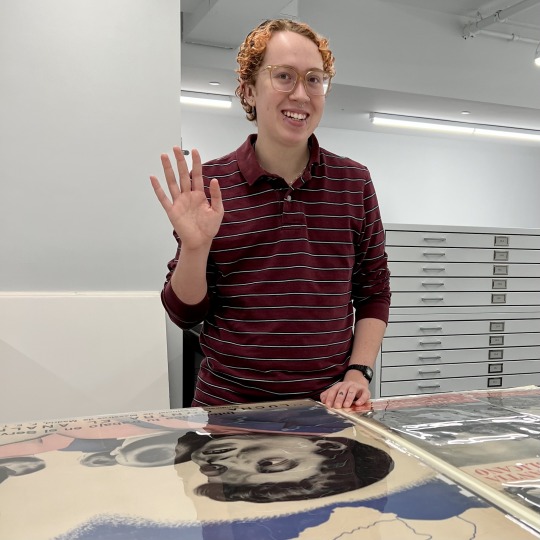
Hi, my name is Mia Lindenburg. I am a graduate student undergoing NYU’s Dual Degree program, where I will get an MA in literature and an MLIS. This semester, I have been working with NYU’s Barbara Goldsmith Preservation & Conservation Department, mentored by Lindsey Tyne (Conservation Librarian), Laura McCann (Director of Preservation), Weatherly Stephan (Head of Archival Collections Management), and Felix Esquivel (Collections Manager, Special Collections), to survey the Spanish Civil War Poster Collection (ALBA.GRAPHICS.001). This internship has helped me to prepare for a future career in special collections libraries, where I will be required to work with delicate material similar to what I see in this collection. I am very thankful for this opportunity and how it has allowed me to delve deeper into archival work with a hands-on approach.
In addition to working with the Preservation department, I have been lucky enough to work with the Archival Collections Management (ACM) and Special Collections departments, allowing me to see the different perspectives of handling a large and often complicated collection. This blog post will demonstrate the different ways in which these departments added to my learning experience and show some of the special facets of working with this collection in particular.
BUILDING THE DATABASE
Before I began surveying this collection, I had to create an infrastructure that would allow me to compile the data I would be collecting. I used the software AirTable to build this database. First, I had to move the data that had already been collected into my table. This came from Archives Space (AS), an archives information management software used by NYU Libraries. This had much of the preliminary data I would need to fact-check against in the survey, such as poster locations. After I had brought the AS data into the table, I created fields that would duplicate the AS fields but with the descriptor (survey) to show any differences. Additionally, I made new fields for things we might want to consider, such as condition and size.
UNIQUE POSTER FORMATS
“I tu? Que fas per la victoria?”

ALBA-ES 46, copy 4 “i tu?” (Photo by: M. Lindenburg)
The first set of posters that I want to discuss is ALBA-ES 45 and 46, also known as the two sides of “I tu? Que fas per la victoria?” a Catalan poster depicting a bloody soldier advocating for his audience to participate in the war, to support the cause. This collection has many copies, encapsulated (meaning this poster is inside a protective mylar sleeve) and unencapsulated, of this poster. The copies pictured below interest me because they were particularly delicate. You can tell from the photos that they were split into pieces, making flipping the posters to inspect the back difficult. These will need a lot of conservation work, although they may not be an immediate priority since so many copies are in fine condition.
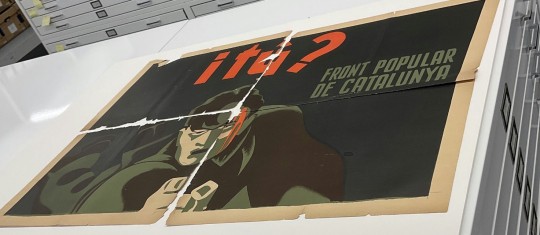
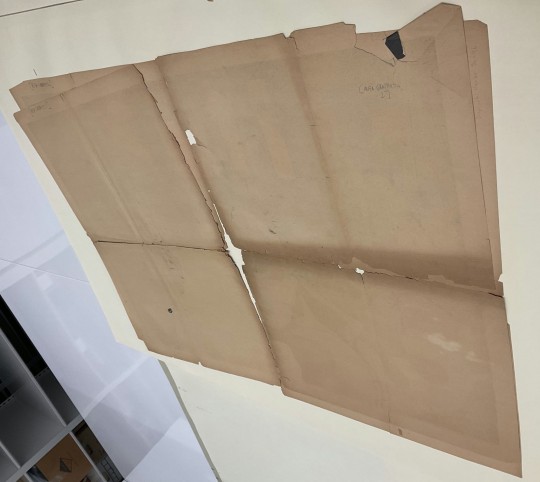
ALBA-ES 45, copy 4 “i tu?” (Photos by: M. Lindenburg)
“Allisteu-vos a les milicies antifeixistes”
The poster “Allisteu-vos a les milicies antifeixistes,” belongs to a series of posters collected at The Franklin Institute in Philadelphia as part of a circulating exhibit.
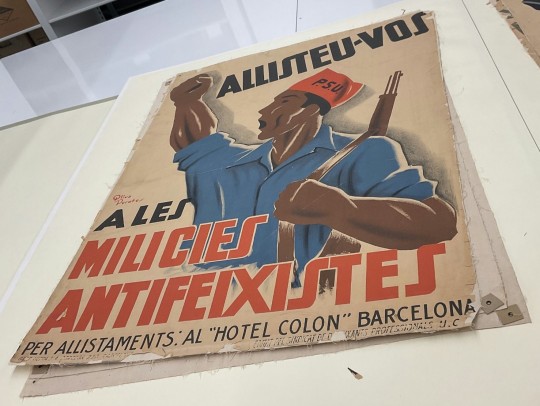
ALBA-ES 116, recto, “Allisteu-vos a les milicies antifeixistes” (Photo by: M. Lindenburg)
These interest me because of how they were mounted for the exhibition. Rather than encapsulating the posters or leaving them untouched, this exhibitor chose to attach muslin across the back and use cardboard and grommets to hang them.
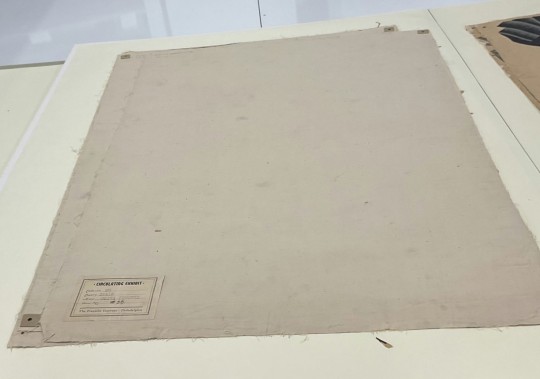
ALBA-ES 116, verso, “Allisteu-vos a les milicies antifeixistes” (Photo by: M. Lindenburg)
Annual Xmas Eve Ball
Poster ALBA-US-15, uses a mounting technique commonly used with posters associated with the Veterans of the Abraham Lincoln Brigade (VALB).
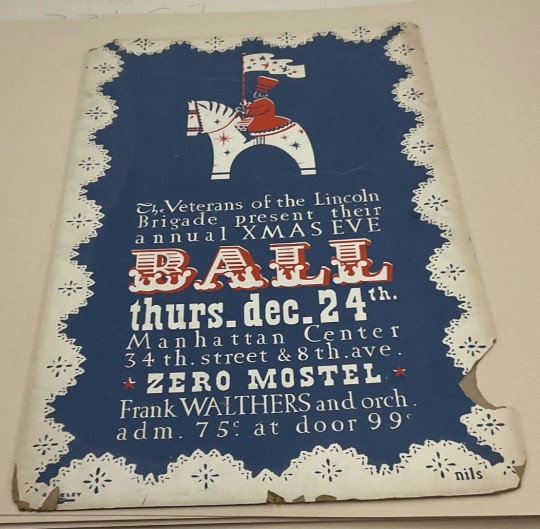

ALBA-US-15 (Photo by: M. Lindenburg)
It is mounted on a paperboard, which makes it somewhat heavy and unwieldy when grouped in folders. Take note of the headline of Zero Mostel, which shows the support the VALB received, even from celebrities.
THE INSCRIBED NAMES & WHO THEY WERE
Archie Brown is a signature I’ve encountered a lot in this collection.

ALBA-ES-8 (Photo by: M. Lindenburg)
Brown was born in 1911 in Sioux City, Iowa. He was brought into the world of labor activism at an early age. 1934, he was arrested at a Young Communist League (YCL) event in San Pedro. But he continued with his activism despite this. In 1937, Brown got tuned into the struggles in Spain, particularly after his brother was recruited to the International Brigade. In San Francisco, Brown was denied a passport because of his radical reputation. So, he went to New York City and stowed away on a ship to France, where he would travel to Spain. He joined the forces of the Abraham Lincoln Brigade and, even after the war, continued to fight as a soldier and an activist.

Archie Brown, 1982 (Photo by: R. Bermack). Image Source.
Harry Hakam is an interesting character, partially because of his frequent correspondence with other members of the Abraham Lincoln Brigade.
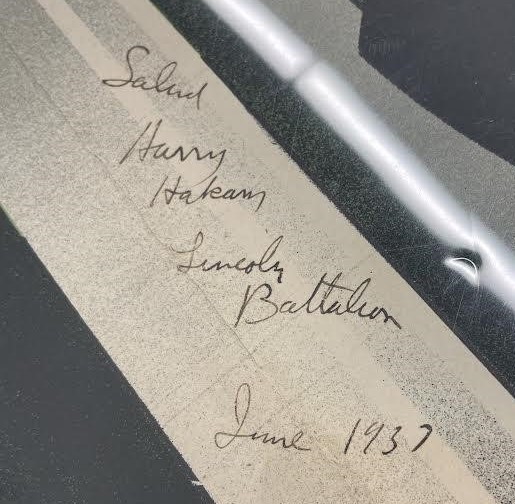
ALBA-ES-77 (Photo by: M. Lindenburg)
Hakam was born in Brooklyn in 1913. In February 1937, he sailed to France, arriving in Spain in March of the same year. He served primarily as a battalion runner, returning to the US in 1938. However, it’s his correspondence that makes him shine. His collection marker (Hakam) is found on many posters that share others’ names, meaning he likely sent these posters back and forth between fellow members.

Harry Hakam. Image Source.
We don’t have as much information on Al Erdberg, but we do know from the Harry Hakam Papers (ALBA.046) and the fact that Erdberg shows up in the Hakam posters that they had correspondence. Erdberg was likely part of the Abraham Lincoln Brigade or a state-side supporter. This would be an interesting figure to research further.

ALBA-ES-30 (Photo by: M. Lindenburg)
REHOUSING
A big problem I encountered when surveying these posters was with the housing rather than the posters themselves. Often, I encountered groups of ten or more posters in a folder, making the folder heavy and difficult to move. Further, if these posters are in mylar encapsulation, they become even heavier. To remedy this, the posters need to be rehoused into sturdier folders. I began some of this work with Laura McCann this semester, and the rehousing of the posters will continue through the summer.
VELCRO STICKERS
Some of the posters I found had velcro stickers left on the mylar encapsulation. These are likely from previous exhibition techniques, where the posters were attached to a wall using velcro. However, this technique is now deemed problematic, so Lindsey Tyne and I used a process to remove these stickers. We used a hot iron to heat small metal spatulas, which we then used to melt the adhesive of the sticker and lift the velcro off. This is a delicate process, but we got into a rhythm and moved fairly quickly.
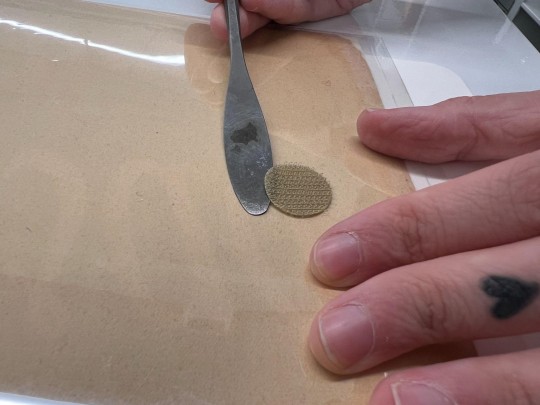
Mia removing velcro (Photo by: L. Tyne)
This collection has taught me many things. I have learned to be patient, think carefully, and always be on the lookout for new observations, among many other smaller skills. If I were asked to advise someone starting a similar project, I encourage them to take note of their natural rhythm so that they can figure out which order of surveying works best for them to maximize efficiency. I would also tell them not to be afraid of asking questions, even if it’s clarifying something they think you already know. This has been an incredible experience, and I feel so lucky to have been a part of this collection. Thank you for taking the time to read my post!
#nyulibraries#nyuspecialcollections#libraryconservation#paperconservation#librarypreservation#preservingthepast
28 notes
·
View notes
Text
Malware Torrents: The Telltale Signs
Be careful with piracy torrents you guys. The majority of them are legit, but every once in a while you'll find someone trying to use them to spread malware. Recently someone uploaded a torrent masquerading as an episode of a TV show I like, but when it downloaded I saw it was actually a disguised shortcut (.lnk file) with a crypto miner attached to it, with just over 1 BILLION zeroes added to the end to make the file big enough to look like a valid video.
The first warning sign was that the episode was uploaded almost 3 days before it actually aired. That's rare, really only happens with hacks/leaks and those are usually newsworthy. Second, my automatic media organizer software refused to import it because it was "not a video file". Again, weird; why wouldn't my software recognize a valid video?
However the BIGGEST red flag was when I went to look at the downloaded file, it had a tiiiiiiiny curved arrow on it indicating that it was actually a shortcut, not a video. When I hovered over it, it showed that it was actually pointing at a completely different file in a protected system directory.


When I viewed the shortcut properties, I could see that it was going to run a command prompt and execute a batch command that installed an executable that would run every time I started my computer (basically, do a bunch of shit it shouldn't be doing. A video file shouldn't even have a target field, let alone one with command prompt stuff in it).
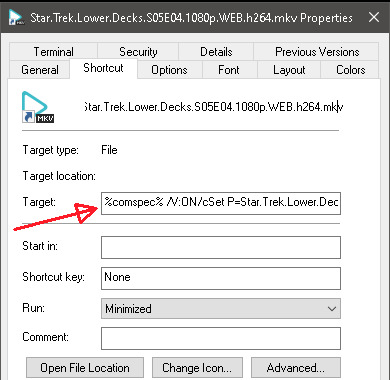
I had to learn how to use a hex editor to delete the billion zeros and separate the .lnk part (the install command) from the actual malware, and the instant I did that Windows Defender flagged it:
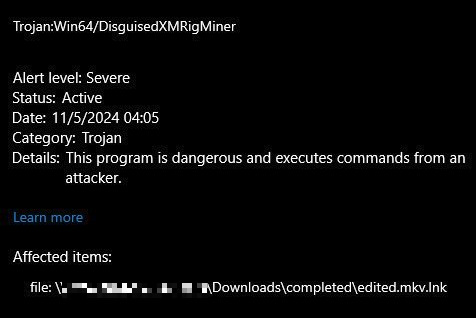
So. How can I identify suspicious torrents ahead of time?
When I went to inspect the torrent, in hindsight it was easy to see it was bad because of the file extension, but you can only see that if you inspect the files in the torrent, not just the torrent name. Many piracy sites don't bother showing you a list of files in the torrent ahead of time, so be sure to inspect them once they're in your download client.

I recommend familiarizing yourself with common media file extensions and then inspecting your torrents for outliers; any file name that includes a non-media extension like .lnk, .exe, .cmd, .bat, .ps1, .sh, etc. is automatically a huge red flag!
Secondly, look for that little shortcut icon before you open anything you download from the internet. And finally, don't ignore suspicious things that are adding up (in this case, the fact it was posted before the episode's actual air date, and the media organizer software flagging it as "not a video").
I think Windows Defender probably would have caught it if I had actually clicked it and the malware had tried to install itself, but our goal is obviously to never get to the point of clicking on viruses at all! So be aware of the warning signs, use antivirus software, and sale the high-seas safely!
#i've only run into stuff like this twice in like 10 years of downloading#so don't let this scare you away from torrenting#just posting to keep people safe and informed#the next thing on my list is a guide to piracy via torrenting but my time and motivation has been very low due to life stuff lately#fingers crossed i get to it soon!#torrenting#piracy#computer security#cybersecurity#mine#long post
16 notes
·
View notes
Text
Ko-fi prompt from @thisarenotarealblog:
There's a street near me that has eight car dealerships all on the same lot- i counted. it mystifies me that even one gets enough sales to keep going- but 8?? is there something you can tell me that demystifies this aspect of capitalism for me?
I had a few theories going in, but had to do some research. Here is my primary hypothesis, and then I'll run through what they mean and whether research agrees with me:
Sales make up only part of a dealership's income, so whether or not the dealership sells much is secondary to other factors.
Dealerships are put near each other for similar reasons to grouping clothing stores in a mall or restaurants on a single street.
Zoning laws impact where a car dealership can exist.
Let's start with how revenue works for a car dealership, as you mentioned 'that even one gets enough sales to keep going' is confusing. For this, I'm going to be using the Sharpsheets finance example, this NYU spreadsheet, and this Motor1 article.
This example notes that the profit margin (i.e. the percentage of revenue that comes out after paying all salaries, rent, supply, etc) for a car dealership is comparatively low, which is confirmed by the NYC sheet. The gross profit margin (that is to say, profits on the car sale before salaries, rent, taxes) is under 15% in both sources, which is significantly lower than, say, the 50% or so that one sees in apparel or cable tv.
Cars are expensive to purchase, and can't be sold for much more than you did purchase them. However, a low gross profit margin on an item that costs tens of thousands of dollars is still a hefty chunk of cash. 15% gross profit of a $20,000 car is still $3,000 profit. On top of that, the dealership will charge fees, sell warranties, and offer upgrades. They may also have paid deals to advertise or push certain brands of tire, maintenance fluids, and of course, banks that offer auto loans. So if a dealership sells one car a day, well, that's still several thousand dollars coming in, which is enough to pay the salaries of most of the employees. According to the Motor1 article, "the average gross profit per new vehicle sits at $6,244" in early 2022.
There is also a much less volatile, if also much smaller, source of revenue in attaching a repairs and checkup service to a dealership. If the location offers repairs (either under warranty or at a 'discounted' rate compared to a local, non-dealership mechanic), state inspections, and software updates, that's a recurring source of revenue from customers that aren't interested in purchasing a car more than once a decade.
This also all varies based on whether it's a brand location, used vs new, luxury vs standards, and so on.
I was mistaken as to how large a part of the revenue is the repairs and services section, but the income for a single dealership, on average, does work out math-wise. Hypothesis disproven, but we've learned something, and confirmed that income across the field does seem to be holding steady.
I'm going to handle the zoning and consolidation together, since they overlap:
Consolidation is a pretty easy one: this is a tactic called clustering. The expectation is that if you're going to, say, a Honda dealership to look at a midsize sedan, and there's a Nissan right next door, and a Ford across the street, and a Honda right around the corner, you might as well hit up the others to see if they have better deals. This tactic works for some businesses but not others. In the case of auto dealerships, the marketing advantage of clustering mixes with the restrictions of zoning laws.
Zoning laws vary by state, county, and township. Auto dealerships can generally only be opened on commercially zoned property.
I am going to use an area I have been to as an example/case study.
This pdf is a set of zoning regulations for Suffolk County, New York, published 2018, reviewing land use in the county during 2016. I'm going to paste in the map of the Town of Huntington, page 62, a region I worked in sporadically a few years ago, and know mostly for its mall and cutesy town center.
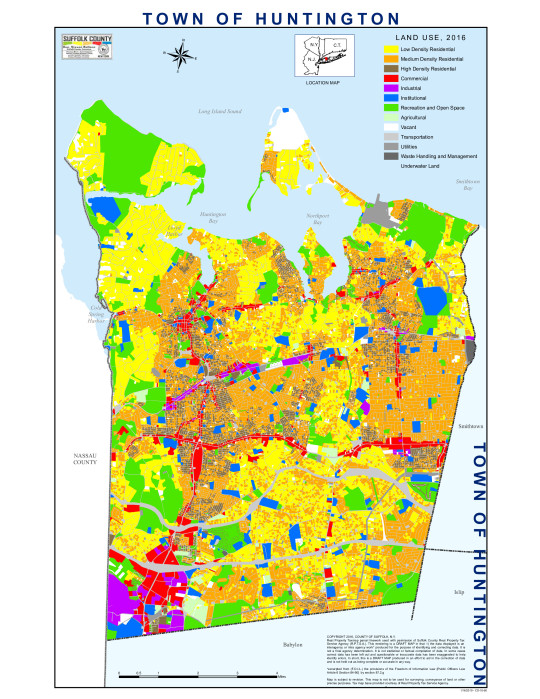
Those red sections are Commercially Zoned areas, and they largely follow some large stroads, most notably Jericho Turnpike (the horizontal line halfway down) and Walt Whitman Road (the vertical line on the left). The bulge where they intersect is Walt Whitman Mall, and the big red chunk in the bottom left is... mostly parking. That central strip, Jericho Turnpike, and its intersection with Walt Whitman... looks like this:

All those red spots are auto dealerships, one after another.
So zoning laws indicate that a dealership (and many other types of commercial properties) can only exist in that little red strip on the land use map, and dealerships take up a lot of space. Not only do they need places to put all of the cars they are selling, but they also need places to park all their customers and employees.
This is where we get into the issue of parking minimums. There is a recent video from Climate Town, with a guest spot by NotJustBikes. If you want to know more about this aspect of zoning law, I'd recommend watching this video and the one linked in the description.
Suffolk county does not have parking minimums. Those are decided on a town or village level. In this case, this means we are looking at the code set for the town of Huntington. (I was originally looking on the county level, and then cut the knot by just asking my real estate agent mom if she knew where I could find minimum parking regulations. She said to look up e360 by town, and lo and behold! There they are.)
(There is also this arcgis map, which shows that they are all within the C6 subset of commercial districting, the General Business District.)
Furniture or appliance store, machinery or new auto sales - 1 per 500 square feet of gross floor area
Used auto sales, boat sales, commercial nurseries selling at retail - 5 spaces for each use (to be specifically designated for customer parking) - Plus 1 for each 5,000 square feet of lot area
This is a bit odd, at first glance, as the requirements are actually much lower than that of other businesses, like drive-in restaurants (1 per 35 sqft) or department stores (1 per 200 sqft). I could not find confirmation on whether the 'gross floor area' of the dealership included only indoor spaces or also the parking lot space allotted to the objects for sale, but I think we can assume that any parking spaces used by merchandise do not qualify as part of the minimum. Some dealerships can have up to 20,000 gross sqft, so those would require 40 parking spaces reserved solely for customers and employees. Smaller dealerships would naturally need less. One dealership in this area is currently offering 65 cars of varying makes and models; some may be held inside the building, but most will be on the lot, and the number may go higher in other seasons. If we assume they need 30 parking spaces for customers and employees, and can have up to 70 cars in the lot itself, they are likely to have 100 parking spaces total.
That's a lot of parking.

Other businesses that require that kind of parking requirement are generally seeing much higher visitation. Consider this wider section of the map:
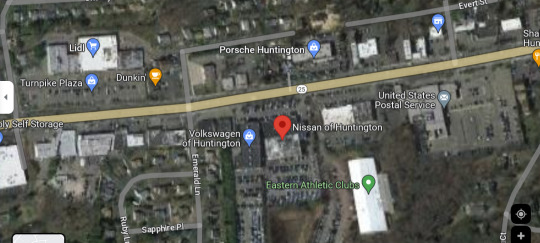
The other buildings with comparative parking are a grocery store (Lidl) and a post office (can get some pretty high visitation in the holiday season, but also just at random).
Compare them, then, to the "old town" section of the same town.
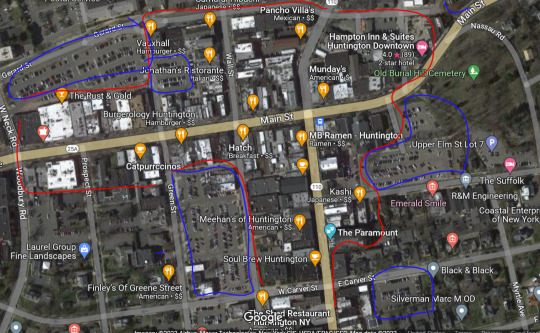
There are a handful of public parking areas nearby (lined in blue), whereas the bulk of the businesses are put together along this set of streets. While there is a lot of foot traffic and vehicle passage, which is appealing for almost any business, opening a car dealership in this area would require not only buying a building, but also the buildings surrounding it. You would need to bulldoze them for the necessary parking, which would be prohibitively expensive due to the cost of local real estate... and would probably get shot down in the application process by city planners and town councils and so on. Much easier to just buy land over in the strip where everyone's got giant parking lots and you can just add a few extra cramped lanes for the merchandise.
Car dealerships also tend to be very brightly lit, which hits a lot of NIMBY sore spots. It's much easier to go to sleep if you aren't right next to a glaring floodlight at a car dealership, so it's best if we just shove them all away from expensive residential, which means towards the loud stroads, which means... all along these two major roads/highways.
And if they're all limited to a narrow type of zoning already, they might as well take advantage of cluster marketing and just all set up shop near each other in hopes of stealing one of the other's customers.
As consumers, it's also better for us, because if we want to try out a few different cars from a few different brands, it's pretty easy to just go one building down to try out the Hyundai and see if it's better than a Chevy in the same price group.
(Prompt me on ko-fi!)
#economics prompts#marketing#zoning laws#ko fi prompts#ko fi#auto industry#automotive dealerships#car dealerships#phoenix posts
110 notes
·
View notes
Text

Intro to Project Hatchling
Greetings to all new D.R.A.G.O.N employees. In regards to those who have been listed as official contributors to Project Hatchling, we implore that this document is read in its entirety, as it will provide a de-briefing on what the project is, what DRAGON aims to achieve, and how to approach the many different fields of work that may be assigned across the project’s lifespan. What is Project hatchling? Project Hatchling is the culmination of multiple decades of hard work and effort from the dedicated employees at DRAGON, and starting in 19XX, we sought out the ambitious goal of exploring and breaching the limits of the human psyche with the creative usage of modern tech. By simulating a different reality parallel to our own, DRAGON hypothesizes that with enough immersion, an individual may treat that perceived reality as completely true to life. From this hypothesis, it was then conceived that the most efficient way to carry out this experiment was to raise groups of subjects from early infancy to adulthood; observing how their minds mature and develop when placed inside an environment in which they dictate and self-craft their own perception of reality from a near base zero. Roles and Responsibilities As a contributor to Project Hatchling, individual staff members will have been assigned to one of three work stations outside of the general internship program:
Subject Research and/or Care
Simulacrum Management and Programming
Artistic Director
In addition to these roles, there are supplementary positions a staff member may be assigned to, including but not limited to:
Security
Subject Unit Maintenance
Eidolon Program Manager
Each position has its own, much more in-depth document that all staff must refer to, whereas this document will describe the general responsibilities that apply to every position listed. Failure to comply and follow these rules and regulations may result in demotion, cuts of pay, and potential termination of employment depending on the severity of the violation. Please keep this in mind, and follow each regulation as tactfully as possible.
1. Ensure that no subject is able to escape their unit. Allowing a subject to leave their unit whilst conscious is strictly prohibited. This can be as simple as ensuring that exits are properly locked when entering/exiting a subject unit, as well as maintaining proper entryway facades within those units. Beyond this, staff must take additional care to ensure their employee keycard is not misplaced as to not lock themself inside or out of a subject unit and potentially giving a subject access to their keycard, or other personal documentation. Wearing a lanyard is highly recommended.
2. Remain hidden from project subjects. With an exception for subjects within the Eidolon Program, all DRAGON employees must take extreme precautions to remain out of view from subjects. If hands-on work (such as subject healthcare, unit maintenance, etc.) is required, then it must be enacted whilst the subject is either asleep or sedated. In the event that a subject escapes from their unit and breaches into the main facility, a code red will be issued amongst all staff. As is regular protocol for a code red situation, staff are required to find a place to hide where a subject will not spot them– such as a locked door or an unlit room, and remain there until the subject is either sedated or returned to their unit.
3. Maintain proper upkeep of subject units. Keeping a subject’s unit clean and intact will ensure a safer environment, a more positive reaction from the subjects themselves, and an overall higher quality of life. This implies regular after-hour cleaning, inspection and maintenance checks that may be performed either whilst a subject is asleep, or undergoing mandatory healthcare sedation. In addition to physical maintenance, routine checks on simulated programs within subject units must be performed in order to account for software updates, potential bugging in object models, or any additional glitches within the system. These software checks should be performed monthly– if not at least once per week.
4. Avoid Anachronism within subject units. As an extension to regulation three, great effort must be made to maintain consistency in subject units as to remain a realistic facsimile of their personal life perception. This means that all objects, simulacrum, and teaching material inside of a subject’s unit must not contradict their perceived reality, and remain consistent to what would be typical for that reality; be it realistic or an act of pure fantasy.
5. Do not discuss the project with outside personnel. As stated before, staff are strictly prohibited from sharing any information about Project Hatchling with anybody beyond those involved directly with the project whilst under NDA. This includes close friends, family members, and even those within DRAGON itself, but not affiliated with the Project Hatchling project branch. Sharing information can potentially put the project in jeopardy, and runs the risk of bad-faith allegations being spread about our cause, goal, and methods.
If a staff member is seen purposefully violating any of these regulations, they will be swiftly approached and taken care of before the situation has any potential to escalate.
For any questions and inquiries, staff are encouraged to reach out to the DRAGON help desk, where our database overseers will be more than willing to assist.
[PT Translation under cut]
Introdução ao Projeto Hatchling
Saudações para todos os novos funcionários da D.R.A.G.O.N.
Para aqueles que foram registrados como contribuidores oficiais para o Projeto Hatchling, imploramos que este documento seja lido por completo, pois ele providenciará um resumo sobre o que é o projeto, o que DRAGON deseja alcançar, e como se preparar para as várias áreas diferentes de trabalho que serão atribuídas ao longo da existência do projeto. O que é o Projeto Hatchling?
Projeto Hatchling é a culminação de múltiplas décadas de trabalho e esforço vindo de funcionários dedicados na DRAGON, e desde o seu começo em 19XX, nós buscamos o ambicioso objetivo de explorar e brechar os limites da mente humana com o uso criativo de ferramentas modernas. Ao simular uma realidade diferente paralela à nossa, DRAGON teoriza que com certa imersão, um indivíduo possa julgar essa cópia como completamente verdadeira.
Desta hipótese, foi então concebido que a maneira mais eficiente de colocar este experimento em prática foi em criar grupos de cobaias desde a infância até a idade adulta; analisando como suas mentes maduram e desenvolvem quando criados em um ambiente onde possam fabricar e raciocinar sua própria noção de realidade de uma base quase zero.
Cargos e Responsabilidades
Ao se tornar parte da equipe do Projeto Hatchling, funcionários individuais serão divididos entre um destes postos de trabalho, além do programa geral de estágio.
Pesquisa e/ou Cuidado de Cobaias
Gestão e Programação do Simulacrum
Direção Artística
Junto a estas funções, têm papéis suplementares qual podem ser atribuídos a um funcionário, incluindo mas não apenas:
Segurança
Manutenção da Unidade de Habitação
Gerenciamento do Programa Eidolon Cada cargo tem seu próprio documento, cujo detalhamento mais aprofundado deve ser aderido por todos dentro do posto em questão, enquanto este documento serve para descrever as responsabilidades gerais que aplicam-se em todos os setores já listados. Fracasso em cumprir e aderir a estas regras e instruções pode resultar em rebaixamento, cortes no salário, e até mesmo em uma rescisão do contrato, dependendo da gravidade da violação. Por favor mantenha tudo isto em mente, e siga com o máximo de cuidado possível cada regulação listada.
1. Certifique que nenhuma cobaia seja capaz de escapar da sua unidade.
Permitir que uma cobaia saia da sua unidade enquanto ainda está consciente é estritamente proibido. Isto pode ser algo tão simples quanto certificando-se de que as saídas estão trancadas adequadamente ao entrar/sair, assim como manter os disfarces adequados das entradas dentro destas unidades de habitação. Além disso, empregados devem tomar cuidado adicional para garantir que não percam o seu cartão de acesso, para não se trancar dentro ou fora da unidade de habitação e potencialmente dando a cobaia acesso ao cartão de acesso, ou qualquer outro documento. Usar um cordão é altamente recomendado.
2. Permaneça fora de vista dos experimentos do projeto.
Com exceção para experimentos dentro do Programa Eidolon, todos os funcionários devem tomar precauções para ficarem fora de vista das cobaias. Se trabalho prático (como atendimento médico da cobaia, manutenção da unidade, etc.) for exigido, então terá que ser feito enquanto a cobaia está adormecida ou sedada. No evento em que uma cobaia escapa e invada os corredores principais do instituto, um código vermelho vai ser ativado para todos os funcionários. Seguindo o protocolo regular deste tipo de situação, exige-se que os funcionários procurem e se escondam em um lugar onde a cobaia não irá encontrá-los— como atrás de uma porta trancada ou um quarto escuro, e que permaneçam lá até a cobaia ser sedada ou retornada à cela.
3. Mantenha o cuidado adequado das unidades de habitação.
Manter uma unidade de habitação limpa e intacta garante um ambiente mais seguro, uma reação mais positiva das cobaias em si, e uma alta qualidade de vida no geral. Significa que é necessário a limpeza, inspeção, e manutenção em horários pós-expediente, ou enquanto a cobaia está adormecida ou submetida a sedação médica mandatória. Além da manutenção física, fiscalização habitual nos programas de simulação dentro dos quartos deve ser feita para prestar contas de atualizações de software, possível bugs no modelo dos objetos, e quaisquer outros erros dentro dos sistemas. Estas checagens devem ser no minímo feitas mensalmente— se não puderem ser feitas semanalmente.
4. Evite anacronismo dentro das unidades.
Adicionando à regulação três, deve ser feito grande esforço para manter consistência dentro das unidades para permanecer um fac-símile realista da percepção de vida pessoal das cobaias. Significa que todos os objetos, simulacrum, e material pedagógico dentro da unidade não devem criar discrepâncias na realidade concebida delas, e devem ser consistentes do que seria típico para aquela realidade; seja algo realista ou algo puramente fantástico.
5. Não mencione o projeto com funcionários exclusos.
Como já declarado anteriormente, funcionários estão estritamente proibidos de compartilhar qualquer informação do Projeto Hatchling com qualquer pessoa que seja além daqueles diretamente involvidos com o projeto quando dentro do AN-D. Incluíndo amigos próximos, parentes, e até mesmo indivíduos que trabalham na DRAGON, mas que não estão afiliados com o ramo específico do Projeto Hatchling. Divulgando informação pode potencialmente colocar o projeto em perigo, correndo risco de alegações maliciosas sendo espalhadas sobre a nossa causa, meta, e métodos.
Se um funcionário for visto violando qualquer uma destas regulações propositalmente, ele será prontamente confrontado e removido antes que a situação possa escalar.
Para dúvidas e questões, funcionários são incentivados a contatar a central de ajuda DRAGON, onde os nossos encarregados estarão mais que felizes em os responder.
18 notes
·
View notes
Text
Getting Started with Industrial Robotics Programming

Industrial robotics is a field where software engineering meets automation to drive manufacturing, assembly, and inspection processes. With the rise of Industry 4.0, the demand for skilled robotics programmers is rapidly increasing. This post introduces you to the fundamentals of industrial robotics programming and how you can get started in this exciting tech space.
What is Industrial Robotics Programming?
Industrial robotics programming involves creating software instructions for robots to perform tasks such as welding, picking and placing objects, painting, or quality inspection. These robots are typically used in factories and warehouses, and are often programmed using proprietary or standard languages tailored for automation tasks.
Popular Robotics Programming Languages
RAPID – Used for ABB robots.
KRL (KUKA Robot Language) – For KUKA industrial robots.
URScript – Used by Universal Robots.
Fanuc KAREL / Teach Pendant Programming
ROS (Robot Operating System) – Widely used open-source middleware for robotics.
Python and C++ – Common languages for simulation and integration with sensors and AI.
Key Components in Robotics Programming
Motion Control: Programming the path, speed, and precision of robot arms.
Sensor Integration: Use of cameras, force sensors, and proximity detectors for adaptive control.
PLC Communication: Integrating robots with Programmable Logic Controllers for factory automation.
Safety Protocols: Programming emergency stops, limit switches, and safe zones.
Human-Machine Interface (HMI): Designing interfaces for operators to control and monitor robots.
Sample URScript Code (Universal Robots)
# Move to position movej([1.0, -1.57, 1.57, -1.57, -1.57, 0.0], a=1.4, v=1.05) # Gripper control (example function call) set_digital_out(8, True) # Close gripper sleep(1) set_digital_out(8, False) # Open gripper
Software Tools You Can Use
RoboDK – Offline programming and simulation.
ROS + Gazebo – Open-source tools for simulation and robotic control.
ABB RobotStudio
Fanuc ROBOGUIDE
Siemens TIA Portal – For integration with industrial control systems.
Steps to Start Your Journey
Learn the basics of industrial robotics and automation.
Familiarize yourself with at least one brand of industrial robot (ABB, KUKA, UR, Fanuc).
Get comfortable with control systems and communication protocols (EtherCAT, PROFINET).
Practice with simulations before handling real robots.
Study safety standards (ISO 10218, ANSI/RIA R15.06).
Real-World Applications
Automated welding in car manufacturing.
High-speed pick and place in packaging.
Precision assembly of electronics.
Material handling and palletizing in warehouses.
Conclusion
Industrial robotics programming is a specialized yet rewarding field that bridges software with real-world mechanics. Whether you’re interested in working with physical robots or developing smart systems for factories, gaining skills in robotics programming can open up incredible career paths in manufacturing, automation, and AI-driven industries.
2 notes
·
View notes
Text
#Lore24 Weekly Post (8/52) - Mobile Support Units
BRIEF DATA
Mobile Support Units are a network of magichines dedicated towards repairing, assisting, and supporting other magichines in dangerous situations or emergencies. They semi-frequently operate in conjunction with the Almandine Order, in the form of a small detachment that is usually stationed on the Itinerant Fist.
The MSUs form a crucial backbone in the magichine society's infrastructure, embodying a commitment to the well-being and functionality of their kind. The MSU's main goal is to assist magichines accessing support--sometimes this means directly supplying care, sometimes getting those in need of care to places where they can receive it, sometimes just assisting others, sometimes a simple emergency repair.
The MSUs operate with a diverse skill set, ranging from emergency repairs to providing medical assistance and logistical support. Equipped with advanced diagnostic tools and nano-repair modules, they can address a spectrum of issues magichines might encounter in the field.
In addition to their reactive role, MSUs engage in proactive measures such as routine maintenance and preventive care programs. This forward-thinking approach aims to identify and address potential issues before they escalate, contributing to the overall sustainability and longevity of the magichine population. MSUs embody a sense of camaraderie and shared responsibility, reinforcing the idea that the strength of magichine society lies not just in individual capabilities but in the collective support and collaboration of its members.
OPERATIONS
Rescue and Recovery Operations: During emergencies such as natural disasters or hostile encounters, MSUs coordinate rescue and recovery efforts to locate and evacuate stranded or incapacitated magichines. They employ specialized search algorithms, deploy rescue drones, and coordinate with other units to ensure swift and efficient operations.
Data Analysis and Research: MSUs contribute to ongoing research efforts in arcane mechanics by collecting and analyzing data from field operations. They document anomalies, record performance metrics, and collaborate with research institutions to advance understanding and innovation in magichine technology.
Emergency Repairs: MSUs are equipped with versatile nano-repair modules capable of swiftly addressing mechanical failures and damage sustained by magichines in the field. Whether it's a malfunctioning limb or a critical system failure, the MSUs excel in on-the-spot repairs.
Medical Assistance: In situations where magichines require medical attention, MSUs provide immediate aid. They carry advanced medical modules capable of diagnosing and treating various health issues, from minor glitches in cognitive functions to more severe physical injuries.
Logistical Support: MSUs play a crucial role in ensuring the smooth logistical operations of the Sun Corps. They coordinate transportation, resource allocation, and communication to enhance the efficiency of magichine missions. This includes managing supply chains and optimizing routes for strategic deployments.
Preventive Maintenance: MSUs implement proactive maintenance protocols to prevent system failures and optimize operational efficiency. This includes conducting routine inspections, performing system checks, and applying software updates to ensure that magichines remain in peak condition.
Environmental Adaptation: MSUs are equipped with modules that allow magichines to adapt to diverse environmental conditions. Whether operating in extreme temperatures, low-gravity environments, or radiation-heavy zones, the MSUs ensure magichines are suitably equipped and protected.
Training and Skill Enhancement: Beyond immediate support, MSUs contribute to the ongoing development of magichines' skills. They organize training programs, share knowledge on latest advancements, and facilitate skill enhancement sessions to ensure magichines are well-prepared for evolving challenges.
Community Outreach: MSUs engage in community-building initiatives by fostering a sense of unity among magichines. They organize events, facilitate communication channels, and act as mediators to address concerns within the magichine society, promoting a cohesive and supportive community.
STRUCTURE
MSUs are organized into regional divisions, each responsible for a designated geographical area or sector of operations. These divisions are led by experienced magichines known as Regional Coordinators, who oversee all MSU activities within their jurisdiction.
MSUs employ cross-functional teams consisting of magichines with diverse skill sets and specializations. These teams may include engineers, medical specialists, logistics experts, and data analysts, enabling MSUs to tackle a wide range of challenges and tasks with precision and efficiency.
The three main ways regional MSU divisions organize their members are:
Rescue Team (1 - 20 operators)
Team Leader: Coordinates and leads small rescue teams during emergencies.
Emergency Medics: Provide immediate medical assistance in crisis situations.
Technical Specialists: Skilled operators for rapid technical solutions.
Communication Operator: Maintains communication between the rescue team and the central command.
Field Engineer: Conducts quick repairs and ensures the functionality of equipment.
Rapid Response Company (100 - 300 operators)
Company Commander: Leads the Rapid Response Company and oversees its operations.
Medical Support Unit: A specialized team with advanced medical capabilities.
Technical Assistance Squad: Rapidly deploys for technical repairs and solutions.
Logistics and Coordination Team: Manages resources, transportation, and communication.
Training Instructors: Conduct ongoing training for the larger unit.
Support Brigade (2500 - 4000 operators)
Brigade Commander: Leads the entire Support Brigade, responsible for major decisions.
Medical Division: Chief Medical Officer and specialized medical teams.
Engineering Corps: Chief Engineer and technicians for extensive technical support.
Logistical and Communication Wing: Coordinates resource allocation and communication strategies.
Training and Education Department: Develops and implements training programs.
Field Units: Small teams specialized in different tasks, deployed as needed.
3 notes
·
View notes
Text
Laser Repair Services: The Heart of Medical and Aesthetic Precision
Precision and dependability are essential in the field of medical and aesthetic treatments—not simply expectations. Here is where Lumenis, a leader in energy-based and laser technologies, has carved out a market for itself by providing solutions that have transformed patient outcomes and care. Even the most sophisticated machinery, meanwhile, occasionally has to be repaired and needs routine maintenance. This is where Lumenis Laser Repair Services come in handy, guaranteeing that these advanced devices operate at peak efficiency and provide secure, efficient treatments.

The Center of Medical Precision and Aesthetics
The innovative Lumenis devices are praised for providing a range of treatments from minimally invasive operations to skin rejuvenation and hair removal. The accuracy of the laser determines the safety and efficacy of these therapies. The smooth functioning of the apparatus is necessary for this accuracy, which is where Lumenis Laser Repair Services come into play.
The Hidden Defense: Repair Services for Lumenis Lasers
Lumenis Laser Repair Services and Cynosure Laser Repair Services make sure these gadgets keep working perfectly. They provide a range of services, encompassing but not restricted to:
Preventive maintenance involves routine inspections to make sure the equipment is operating within ideal bounds and guards against unplanned malfunctions.
Continually Fixes: Rapid, effective repair services to minimize downtime by addressing unforeseen problems.
Software Updates: Changing the software on the gadget to make sure it complies with the most recent security and treatment guidelines.
Replacement of Parts: To ensure lifespan and dependability, original parts should be used to replace worn or broken components.
Training and assistance: Ensuring practitioners fully comprehend and make use of the capabilities of the device by providing them with thorough training and assistance.
Lumenis Laser Repair Services and Syneron Laser Repair Services make sure that each device's journey is about upholding a tradition of quality, safety, and innovation in addition to the treatments it offers. It's an original viewpoint that celebrates the larger influence of these devices on healthcare and patient well-being in addition to highlighting the significance of Lumenis Laser Repair Services.
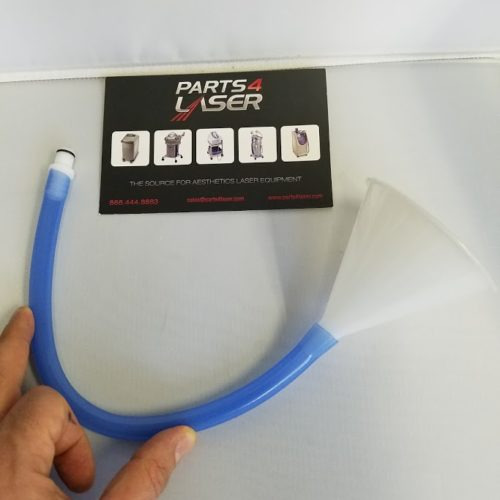
Follow our Facebook and Twitter for more information about our product.
#Cynosure Laser Repair Services#Syneron Laser Repair Services#Cutera Laser Repair Services#Lumenis Laser Repair Services
2 notes
·
View notes
Text
Enhancing Construction Quality Assurance: The Role of Construction Inspection Software - Blog - iFieldSmart Technologies
In the ever-evolving landscape of construction projects, maintaining high standards of quality and compliance is non-negotiable. From ensuring structural integrity to adhering to safety regulations, meticulous inspections play a pivotal role in the success of any construction endeavor. However, traditional paper-based inspection methods are often cumbersome and prone to errors, leading to inefficiencies and delays. Enter Construction Inspection Software – a transformative solution designed to revolutionize the way construction inspections are conducted and managed. In this article, we’ll explore the features, benefits, and impact of Construction Field Inspection Software on the construction industry.
visit : www.ifieldsmart.com/inspections
#construction management software#Construction inspection software#Construction Site Inspection Software#Field Inspection Software#Construction#Civil#civil engineering#technology#building technology#inspection software#inspection#field inspection#software
0 notes
Text
The Importance of High-tech Rapid Prototyping
In the industrial industry, precision is not only desirable—it is essential. Consider a situation in which parts of a jet engine are even marginally machined incorrectly or misaligned. The repercussions can be disastrous and might cause the engine to fail in midair. Precision becomes the key to success in sectors like aerospace, automotive, and medical where safety and dependability are non-negotiable. Put simply, it's the capacity to manufacture parts or components that precisely conform to given dimensions, tolerances, and quality requirements. It takes state-of-the-art equipment, painstaking attention to detail, and highly competent operators to achieve this degree of accuracy. This is the sweet spot for Precision CNC Machining.
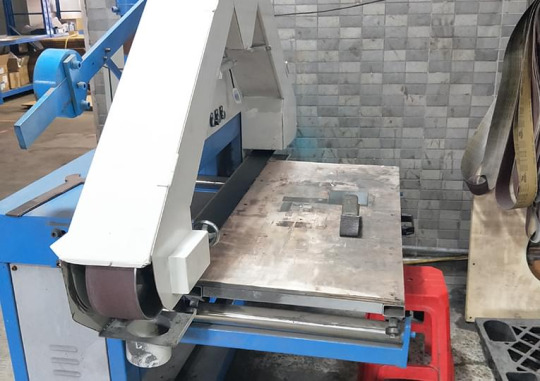
So how precisely can CNC machining accomplish such high precision levels?
Computerized Control: Advanced computer software is the brains of CNC machining, translating digital design requirements into exact motions and orders for the milling tools. This removes the possibility of human error and guarantees the highest level of precision in each cut, drill, and mill.
Superior Quality Equipment: Modern spindles, tools, and cutting implements that are designed to provide exact results are standard on CNC machines. These devices may operate at extremely tight tolerances, which are sometimes expressed in microns, guaranteeing an accurate reproduction of even the minutest features.
Consistency: The ability of CNC machining and High-tech Rapid Prototyping to manufacture similar components with little variance is one of its main advantages. A machine program that has been developed and tuned may be repeated endlessly with reliable outcomes. In fields where stability and dependability are critical, this degree of constancy is priceless.
Advanced Techniques: Multi-axis milling, turning, EDM (Electrical Discharge Machining), laser cutting, and other state-of-the-art methods are all included in CNC machining. With unmatched accuracy and efficiency, manufacturers can handle complicated geometries and materials thanks to these procedures.
Quality Assurance: CNC systems frequently include integrated quality control mechanisms including automated inspections, feedback loops, and real-time monitoring in addition to accurate machining. This reduces waste and rework by guaranteeing that any deviations from the intended standards are quickly identified and fixed. It is impossible to exaggerate the value of accuracy in production. Precision by Precision CNC Machining Manufacturer plays a crucial role in today's competitive economy, as it ensures everything from satisfying regulatory requirements and consumer expectations to assuring product performance and dependability.
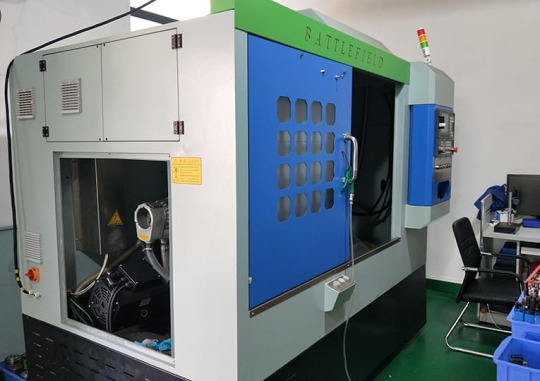
Follow our Facebook and Twitter for more information about our product
#High-tech Rapid Prototyping#Precision CNC Machining#Precision CNC Machining Manufacturer#CNC Machining Manufacturer Company
2 notes
·
View notes
Text
Open-Source Platform Cuts Costs for Running AI - Technology Org
New Post has been published on https://thedigitalinsider.com/open-source-platform-cuts-costs-for-running-ai-technology-org/
Open-Source Platform Cuts Costs for Running AI - Technology Org
Cornell researchers have released a new, open-source platform called Cascade that can run artificial intelligence (AI) models in a way that slashes expenses and energy costs while dramatically improving performance.
Artificial intelligence hardware – artistic interpretation. Image credit: Alius Noreika, created with AI Image Creator
Cascade is designed for settings like smart traffic intersections, medical diagnostics, equipment servicing using augmented reality, digital agriculture, smart power grids and automatic product inspection during manufacturing – situations where AI models must react within a fraction of a second. It is already in use by College of Veterinary Medicine researchers monitoring cows for risk of mastitis.
With the rise of AI, many companies are eager to leverage new capabilities but worried about the associated computing costs and the risks of sharing private data with AI companies or sending sensitive information into the cloud – far-off servers accessed through the internet.
Also, today’s AI models are slow, limiting their use in settings where data must be transferred back and forth or the model is controlling an automated system.
A team led by Ken Birman, professor of computer science in the Cornell Ann S. Bowers College of Computing and Information Science, combined several innovations to address these concerns.
Birman partnered with Weijia Song, a senior research associate, to develop an edge computing system they named Cascade. Edge computing is an approach that places the computation and data storage closer to the sources of data, protecting sensitive information. Song’s “zero copy” edge computing design minimizes data movement.
The AI models don’t have to wait to fetch data when reacting to an event, which enables faster responses, the researchers said.
“Cascade enables users to put machine learning and data fusion really close to the edge of the internet, so artificially intelligent actions can occur instantly,” Birman said. “This contrasts with standard cloud computing approaches, where the frequent movement of data from machine to machine forces those same AIs to wait, resulting in long delays perceptible to the user.”
Cascade is giving impressive results, with most programs running two to 10 times faster than cloud-based applications, and some computer vision tasks speeding up by factors of 20 or more. Larger AI models see the most benefit.
Moreover, the approach is easy to use: “Cascade often requires no changes at all to the AI software,” Birman said.
Alicia Yang, a doctoral student in the field of computer science, was one of several student researchers in the effort. She developed Navigator, a memory manager and task scheduler for AI workflows that further boosts performance.
“Navigator really pays off when a number of applications need to share expensive hardware,” Yang said. “Compared to cloud-based approaches, Navigator accomplishes the same work in less time and uses the hardware far more efficiently.”
In CVM, Parminder Basran, associate research professor of medical oncology in the Department of Clinical Sciences, and Matthias Wieland, Ph.D. ’21, assistant professor in the Department of Population Medicine and Diagnostic Sciences, are using Cascade to monitor dairy cows for signs of increased mastitis – a common infection in the mammary gland that reduces milk production.
By imaging the udders of thousands of cows during each milking session and comparing the new photos to those from past milkings, an AI model running on Cascade identifies dry skin, open lesions, rough teat ends and other changes that may signal disease. If early symptoms are detected, cows could be subjected to a medicinal rinse at the milking station to potentially head off a full-blown infection.
Thiago Garrett, a visiting researcher from the University of Oslo, used Cascade to build a prototype “smart traffic intersection.”
His solution tracks crowded settings packed with people, cars, bicycles and other objects, anticipates possible collisions and warns of risks – within milliseconds after images are captured. When he ran the same AI model on a cloud computing infrastructure, it took seconds to sense possible accidents, far too late to sound a warning.
With the new open-source release, Birman’s group hopes other researchers will explore possible uses for Cascade, making AI applications more widely accessible.
“Our goal is to see it used,” Birman said. “Our Cornell effort is supported by the government and many companies. This open-source release will allow the public to benefit from what we created.”
Source: Cornell University
You can offer your link to a page which is relevant to the topic of this post.
#A.I. & Neural Networks news#agriculture#ai#ai model#applications#approach#artificial#Artificial Intelligence#artificial intelligence (AI)#augmented reality#Bicycles#Cars#cascade#Cloud#cloud computing#cloud computing infrastructure#collisions#Companies#computation#computer#Computer Science#Computer vision#computing#dairy#data#data storage#Design#Developments#diagnostics#Disease
2 notes
·
View notes
Text
「Forest whispers」 Prequel
Reminder!
The story in this article is purely fictional! If there is any similarity, it is purely a coincidence
————————————————————————
In the damp and dark room, moonlight reflected through the skylight glass onto the floor. A man lay on the ground with scars and struggled to breathe. His face was covered in bruises, and upon closer inspection, the floor beneath his body was covered in blood stains.
Looking at the only bright light, his weathered face showed a hint of fatigue, but he seemed to have seen something beautiful and smiled
"Don't think about looking for things over there, you're already in danger, aren't you?"
With a snap, sparks appeared in the darkness, and a person walked over with a cigarette in his mouth. He looked down at the man on the ground, who was dying but still laughing, and crouched down.
His figure blocked the light in the man's field of vision, and smoke swirled in the air. He took out a photo from his pocket, smiled, and held it on his left hand, shaking it in front of the man.
"I believe you are very familiar with this person."
The man lying on the ground shifted his gaze to the photo in front of him. After recognizing the person in the photo under the faint moonlight, his pupils contracted and he almost tried his best to squeeze out the voice from his throat.
"You... dare to... touch my daughter... give it a try..."
Although the man on the ground was very weak at this moment, he could still see the ferocity in his eyes. The person squatting in front of him chuckled as if hearing a joke. He bit his cigarette and lifted his right hand to lightly pat the man's face.
"I can naturally not touch her, provided that... you tell me the secret in Lapland Forest..."
Speaking of which, he grabbed the man's hair and forced him to lift his head. The threat in his words could be said to be undisguised
"You spent half your life there. I don't believe you don't know anything!"
Suddenly, the sound of explosions pierced into their ears, and the flames and smoke filled the entire room. Before he could recover from the intense explosion, he was knocked down by the man lying on the ground.
The flames around illuminated the entire room, and the man seemed to suddenly regain all his strength. He held down the person below with both hands, struggling to stop him from getting up with all his strength. At this moment, the person lying on the ground finally realized the uncontrollability of the situation.
"What did you do!" he roared, his eyes bloodshot
The man smiled, and the flames illuminated his entire face, like a demon crawling from the ground.
"Don't you... think I'll be caught by you like a fool?"
"Let's go to hell together."
The explosion reappeared, and the heat wave overturned the two people.
The man lay on the ground panting weakly, the burning pain constantly eroding his nerves, and he could clearly feel life slowly burning out with this flame.
On his deathbed, he tilted his head and vaguely noticed the photo that had fallen next to him from his perspective. Trembling, he lifted his burnt, flesh blurred hand and struggled to pick it up.
He seemed to see the girl with a bright smile again in front of him, tears drowning in his eyes and brushing across his cheeks. His voice was hoarse, and there was guilt and reluctance in his eyes.
"I'm sorry... my child..."
The firelight illuminated this snow-white land, and the aurora in the sky floated like ribbons illuminating the entire night sky.
————————————————————————
I am trying to translate, and there may be many grammar problems or difficulties in reading. Please remind me and I will make corrections to the errors. Thank you!
May I ask everyone how to create a collection? I am not very proficient in using this software
2 notes
·
View notes
Text
Best Logistics Fleet Management Software
In the rapidly evolving world of logistics, effective fleet management is the key to success.
Whether you oversee a fleet of trucks, delivery trucks, or a combination of vehicles, having the right logistics fleet management software can be a game changer. These software solutions are designed to streamline operations, reduce costs and improve overall efficiency. In this article, we'll explore some of the best logistics fleet management software options available, each offering unique features to help businesses navigate the path to efficiency.

1. Geotab:
Geotab is a comprehensive fleet management software known for its real-time tracking, route optimization, and maintenance tracking. It's a versatile solution suitable for fleets of all sizes.
2. Samsara:
Samsara offers a robust fleet management platform with features like real-time GPS tracking, driver safety monitoring, and vehicle diagnostics.
It's a favorite among businesses looking to enhance safety and compliance.
3. Teletrac Navman:
Teletrac Navman provides fleet management software focused on real-time tracking, compliance and driver behavior monitoring.
This is the preferred choice for companies looking to improve driver performance and reduce fuel costs.
4. Fleet Complete:
Fleet Complete offers a comprehensive suite of fleet management tools, including GPS tracking, dispatching and asset management. It is highly adaptable and can cater to different industries.
5. KeepTruckin:
KeepTruckin is known for its user-friendly fleet management software. It offers features like electronic logging, IFTA reporting, and vehicle inspections, making it a great choice for small to medium fleets.
6. Verizon Connect:
Verizon Connect provides GPS fleet tracking software focused on route optimization, fuel management and field service automation. It is ideal for businesses looking to reduce costs and increase productivity.
7. Route4Me:
Route4Me offers advanced route optimization software, perfect for last-mile delivery operations. It offers real-time tracking, geolocation, and route planning capabilities, making it an essential tool for businesses delivering to customers.
8. WorkWave Route Manager:
WorkWave Route Manager is a cloud-based fleet management solution designed for mobile workforces. It offers route optimization, GPS tracking, and reporting, making it an ideal choice for delivery businesses.
Selecting the right logistics fleet management software is crucial for businesses seeking to stay competitive and efficient in the logistics industry. These software solutions cater to a wide range of needs, from real-time tracking and route optimization to driver safety and compliance.
As the logistics landscape continues to evolve, having the best fleet management software can put your business on the path to success.
5 notes
·
View notes